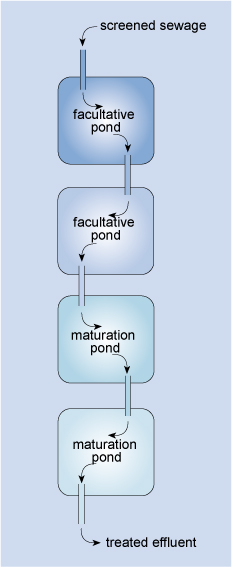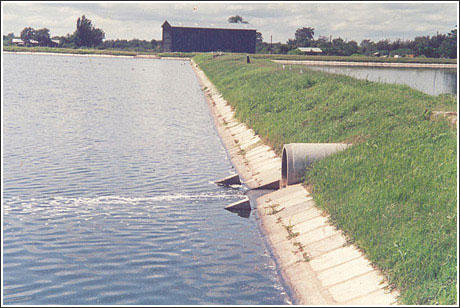11.3.1 Waste stabilisation ponds
Waste stabilisation ponds are natural or constructed ponds used for treating sewage or other wastewaters biologically by harnessing the power of sunlight and wind. They are therefore ideal for tropical countries, and in Ethiopia there is such a system at Kality, treating the sewage from Addis Ababa.
In a typical waste stabilisation pond system, effluent that has passed through a screen is sent through a series of ponds with a total retention time of 10–50 days. (The retention time, in this context, is the length of time the effluent stays in the ponds.) No mechanical equipment is used in the ponds, so operation and maintenance costs are very low. Figure 11.7 shows a typical layout for a waste stabilisation pond system treating domestic sewage.

Bacteria in the ponds oxidise the pollutants and work symbiotically with algae, which provide oxygen through photosynthesis. (A symbiotic relationship means two types of living organisms live together for their mutual benefit. In this case, the algae produce the oxygen that the bacteria need, and the bacteria produce carbon dioxide and release ammonia and phosphate that the algae consume.)
Oxygenation also occurs through the action of wind, and by diffusion. Diffusion is the movement of a substance from a region of high concentration to one of low concentration. In the present context it means the movement of oxygen from the air, where it makes up 21% of the composition, to the water, where it is in low concentration.)
The major part of the biodegradation of the sewage (the breaking down of complex substances in sewage into simpler compounds, by micro-organisms) takes place in the facultative ponds (Figure 11.7). These are ponds in which the upper portion is aerobic and the lower portion is anaerobic. Facultative ponds are 1–1.5 m deep, with a retention time of 5 to 30 days. Solids settle to the bottom and are anaerobically digested by bacteria, so that sludge removal is rarely needed.
Maturation ponds are ponds placed after facultative ponds, for the purpose of pathogen reduction. They are usually 0.5–1.5 m deep, with a retention time of 15 to 20 days. The ponds serve to inactivate pathogenic bacteria and viruses through the action of UV radiation from sunlight and by the greater algal activity in these shallow ponds, which raises the pH to above 8.5 (when pathogens are rapidly killed off). The long retention time in each of the ponds also enhances the sedimentation of eggs of intestinal nematodes (parasitic worms).
To prevent sewage from leaching away, and to preserve the effluent for reuse later, the ponds should have a liner. This can be made of clay, asphalt, compacted earth, or any other impervious material (material that does not let anything through). To prevent run-off from entering the ponds, and to prevent erosion, a protective, raised earth barrier can be constructed around the ponds using the excavated material from their construction. A fence is needed to keep people and animals out (Tilley et al., 2014).
Any scum that builds up on the surface of the facultative and maturation ponds should be removed to allow sunlight to reach all the algae, and also to increase surface aeration. Large plants that are present in the water should be removed.
A further benefit of waste stabilisation ponds is that at the same time as treating wastewater, they can be used to increase protein production through the rearing of fish (such as Tilapia) and ducks in the maturation ponds.
Figure 11.8 shows part of waste stabilisation pond system.

Waste stabilisation ponds are especially efficient in hot climates. Although they require large areas of land, this need can be satisfied by locating the ponds at the outer perimeter of cities or on disused land. At the Kality waste stabilisation ponds on the outskirts of Addis Ababa, the system consists of one facultative pond and three maturation ponds, with a total retention time of 28 days. In an evaluation of Addis Ababa’s sewage treatment system in 2010, Dagne found that an average of 83.6% of the organic pollutants was removed by the process.
11.3 Treating sewage for reuse
